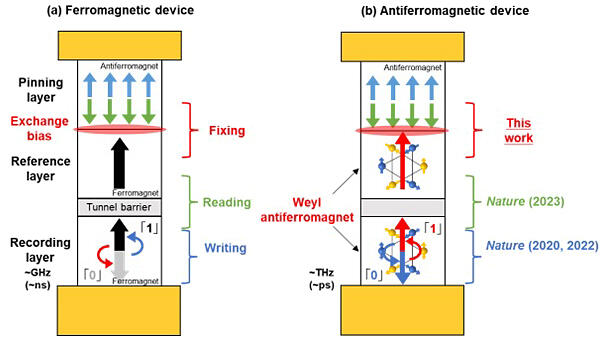A research group led by a Graduate Student Mihiro Asakura, Project Associate Professor Tomoya Higo, and Professor Satoru Nakatsuji of the Graduate School of Science at the University of Tokyo has discovered that the magnetic order in the Weyl antiferromagnet Mn3Sn, which has garnered attention as a next-generation nonvolatile memory material, can be controlled through exchange bias. This is an important step toward the realization of next-generation memory with ultrahigh speed and ultralow power consumption using antiferromagnetic materials and is expected to be applied to new principles of computation, such as brain-type computation and multilevel recording. The result was published in Advanced Materials.

Provided by the University of Tokyo
To cope with increasing data-transmission volume, magnetoresistive random-access memory (MRAM), a nonvolatile memory that can hold data without consuming power, is in the process of being commercialized and developed towards practical application. In MRAM, a ferromagnetic material is used for the magnetic tunnel junction (MTJ) element, which is responsible for nonvolatile recording of data. By replacing this ferromagnetic material with an antiferromagnetic material, it is possible to dramatically increase the operating frequency from the gigahertz to the terahertz band. Due to this development of antiferromagnetic materials for MRAM is underway to realize memory that is nonvolatile (power saving) and has ultrahigh speed.
The research group has developed the Weyl antiferromagnet Mn3Sn, whose topological electronic state is important, and has demonstrated that it is a suitable antiferromagnetic memory material to replace ferromagnetic materials by demonstrating electrical writing and reading of nonvolatile data (magnetic state), an essential function for MRAM applications. This study found that an exchange bias appears at the interface between Mn3Sn and a different magnetic material and that the magnetic state of Mn3Sn can be controlled using exchange bias. Exchange bias is also used in conventional MRAM as a means of stabilizing the magnetic state of certain ferromagnetic layers in MTJ elements to reduce the error rate when reading and writing data as well as to improve thermal stability.
This result, which shows that the magnetic state of antiferromagnetic memory materials can be stabilized through exchange bias, is expected to lead to technology that will be central in realizing ultrafast and ultra-power-efficient memory, which will be as important as the writing and reading functions. Moreover, this result was obtained at the interface between polycrystalline materials fabricated on a thermally oxidized silicon substrate using a sputtering method, which allows the use of a manufacturing process that is also compatible with existing semiconductors and MRAM. Furthermore, the observed exchange bias has unique properties that can lead to applications in new principles of computing, such as brain-type computation and multilevel recording. Therefore, further progress in research toward the realization of high-speed, power-saving information processing technology is desirable.
Journal Information
Publication: Advanced Materials
Title: Observation of Omnidirectional Exchange Bias at All-Antiferromagnetic Polycrystalline Heterointerface
DOI: 10.1002/adma.202400301
This article has been translated by JST with permission from The Science News Ltd. (https://sci-news.co.jp/). Unauthorized reproduction of the article and photographs is prohibited.




